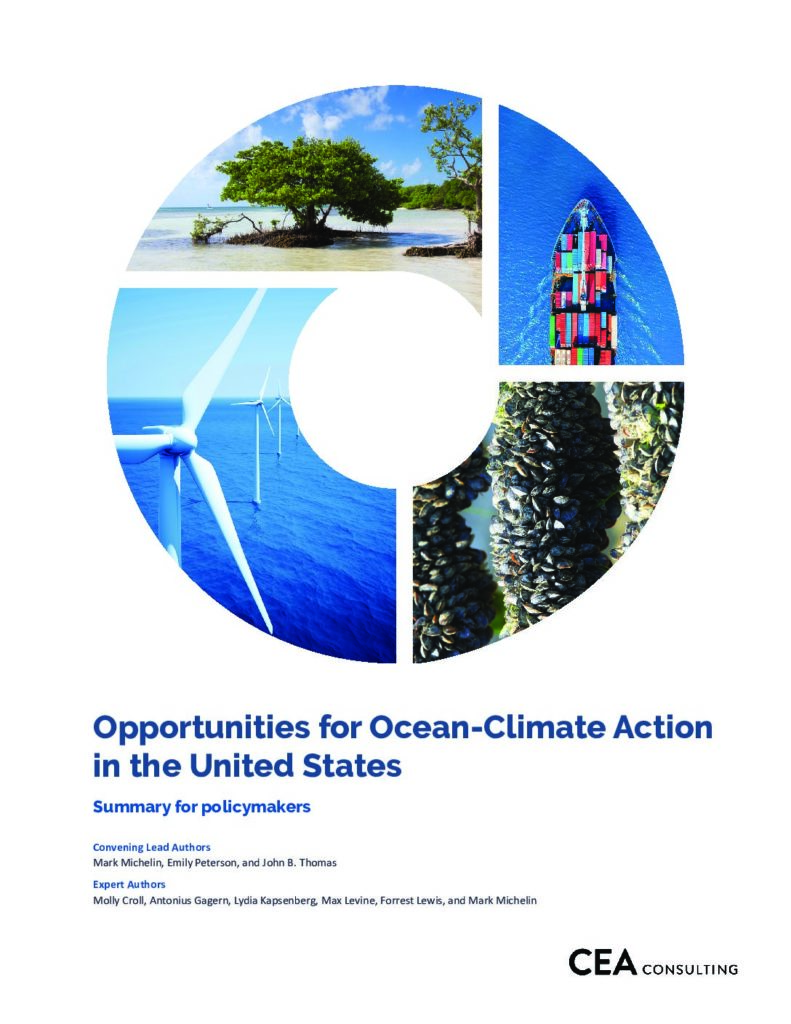The report Opportunities for Ocean-Climate Action in the United States provides a first-ever quantification of the potential for ocean-based climate solutions in the United States. This report provides independent, non-partisan analysis to inform efforts around ocean-based climate action at the federal and state level. Jump to the webinar recording.

Photos: (mussels) Sergii Rudiuk/shutterstock; (mangroves) Matt Tilghman/shutterstock; (underground salt mine) Photografiero/shutterstock; (ship) joyfull/shutterstock
The report analyzes five areas of ocean-based action to mitigate climate change:
- Offshore wind and other marine renewable energy deployment such as wave and tidal power, and ocean salinity energy technology;
- Coastal “blue carbon” ecosystem protection, restoration, and cultivation;
- Decarbonizing U.S. shipping, including efforts to reduce emissions from domestic shipping between U.S. ports as well as international shipping between U.S. ports and foreign ports on American vessels through zero-emission vessels and operational measures;
- Fisheries and aquaculture efficiency improvements, including stronger fisheries management, vessel and refrigeration efficiency technology, low-emissions aquaculture operations and feeds—as well as dietary shifts toward seafood and away from meat consumption; and
- Carbon dioxide storage below the seabed through a range of technologies that capture, transport, and store carbon dioxide captured from heavy polluting sources (such as power plants)
The report was prepared by CEA Consulting and commissioned by the David and Lucile Packard Foundation. It provides a U.S.-level lens to build upon similar analysis conducted at the global level by the High Level Panel for a Sustainable Ocean Economy, summarized in The Ocean as a Solution to Climate Change: Five Opportunities for Action.
You can access the report here:
Key takeaways from this report include:
- Investments in ocean-based climate mitigation measures can reduce U.S. greenhouse gas emissions by up to 13.7 percent annually by 2050. This is equivalent to 90 percent of the annual greenhouse gas emissions from all passenger vehicles in the United States in 2018. Until recently, the ocean and coasts have received little consideration in policy proposals to reduce emissions despite their importance in regulating our climate and their contribution to the U.S. economy.
- Expanding offshore wind production is the most decisive investment that could be made today as it has the greatest mitigation potential of all measures modeled. Offshore wind energy alone could reduce U.S. emissions by up to eight percent over the next 30 years. Offshore wind is commercially viable today, with nearly 28,000 MW of offshore wind capacity installed globally, compared to just 42 MW in the U.S. The U.S. will need to set national targets, invest in market development, streamline the permitting and development process, assess and address cumulative impacts to the marine environment and marine species, and determine how to address competing interests and needs in order to scale offshore wind deployment.
- All mitigation measures included in this analysis have significant co-benefits for jobs, economic recovery and growth, American global competitiveness, public health, environmental justice, and the environment. By reducing air pollution, spurring economic activity in growing industries, and protecting our natural resources, these solutions, taken together, can deliver positive benefits in the form of job creation, economic growth, and environmental justice—while also reducing greenhouse gas emissions. For example, building 30 GW of offshore wind installation in the U.S. by 2030 could create 83,000 jobs annually in construction, operations, supply chain, manufacturing, and supporting industries as well as $25 billion in annual economic output.
Opportunities for ocean-climate action and associated annual mitigation potential in 2050

Graphic reproduced from Hoegh-Guldberg. O., et al. 2019 with permission from the World Resources Institute
To achieve the required emissions reductions and put the U.S. on a lower-risk climate trajectory, mitigation and adaptation measures are needed from all sectors of the U.S. economy, including the ocean and coastal economies. Leaders and experts globally have aligned on a 1.5-degree Celsius trajectory as the scenario that presents a reasonable chance of managing climate impacts, with the 2-degrees Celsius scenario presenting a less desirable option. The 1.5-degree scenario will only be feasible if significant mitigation action is taken in the next ten years.
This report also includes recommendations on policy, research, and technology needs to make these interventions a reality. Not all ocean-based mitigation measures are at the same stage of implementation or have the same level of technical or economic viability, risk, and certainty. While some are well-established and could be rapidly scaled up today, several approaches will require significantly more research, technology development, planning, and policy support—which are ripe for investment by the public, private, and philanthropic sectors.
Slide deck and webinar recording
US_Wedge_Analysis_Presentation_Slides_012821
Download a PDF of the deck







